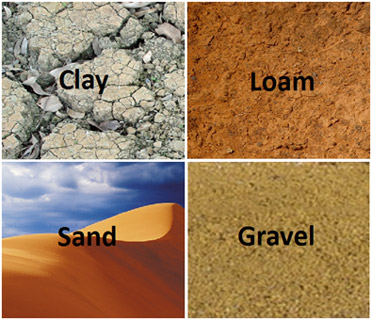.............................................................................................................................................
By: Haseeb Jamal
Gravel
· Course grained
soils that possess little or no cohesion.
· Distinguished by
their relative stability under wheel loads when confined, by their high
permeability and by their low shrinkage and expansion in deter mental amount
with change in soil moisture content.
· Size range from 2
mm to 60 mm
Sand:
· Fine grained soils of low to medium
plasticity intermediate in size b\w sand & clay.
· Organic soils
contain appreciable amount of decomposed organic matter and is generally highly
compressible & unstable.
· Size of sand ranges
from 0.06 mm to 2 mm
Silt
· The size of silt
particles range from 0.002 mm to 0.06 mm
Clay:
· Fine grain soil of
size 0.002 mm or finer.
Types:
- Lean clay: Silty clay.
- Flat clay: Finer colloidal clay with high
plasticity
- Clay may possess considerable strength in
their natural state; this strength is sharply reduced and sometimes
completely destroyed when their natural structure is disturbed, that is
when they are remolded.
Loam:
· Sandy loam
· Silty loam &
· Clay loam
Depending on the size of predominant soil fraction
Loess:
· Uniform grain size
predominantly silts with low density.
Muck:
· Soft silt or clay
very high in organic content
· Found in swampy
areas and rivers or lake bottoms.
Peat:
· Composed of
practically decomposed vegetable matter
· Due to high water
content, woody natural and high compressibility it is extremely undesirable for
use in roads.
Haseeb
Jamal. I am a Civil Engineer,
graduated from University
of Engineering and Technology, Peshawar, Pakistan in 2010. I also
have a PG-Diploma in Disaster Management and
MS in Urban
Infrastructure Engineering (In Progress). My expertise include civil
related softwares like AutoCAD,
SAP2000, MS Project, Primavera, MS Office and GIS. My technical skills include
project management, monitoring and evaluation, structural assessment, disaster
risk management, Quantity survey, land survey, material testing, site
management and technical writing. I am trained in writing project progress
reports as well as proposals and concept papers. I have also received advanced
training on surveying, proposal writing, Monitoring and Evaluation of projects
as well as organizations.
I have worked as Project Engineer at National
Research and Development Foundation, Peshawar and CENCON Associates. I also
worked with Spectra Engineering Solutions as Senior Civil Engineer in
monitoring of World Bank and UNDP funded projects all over Khyber Pakhtunkhwa
and FATA. Currently, I am working as Deputy Manager Development at
NayaTel, Peshawar.


No comments:
Post a Comment